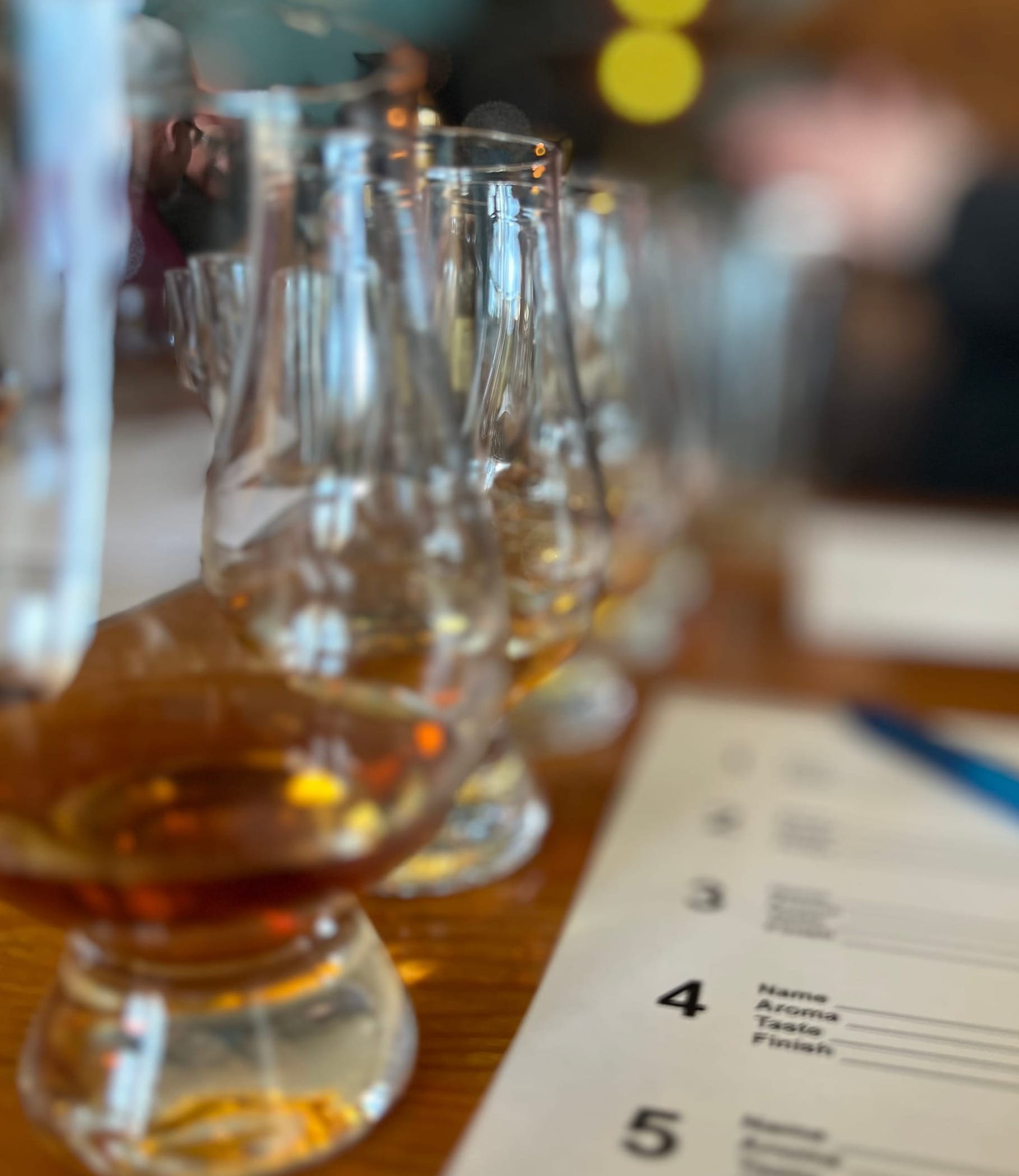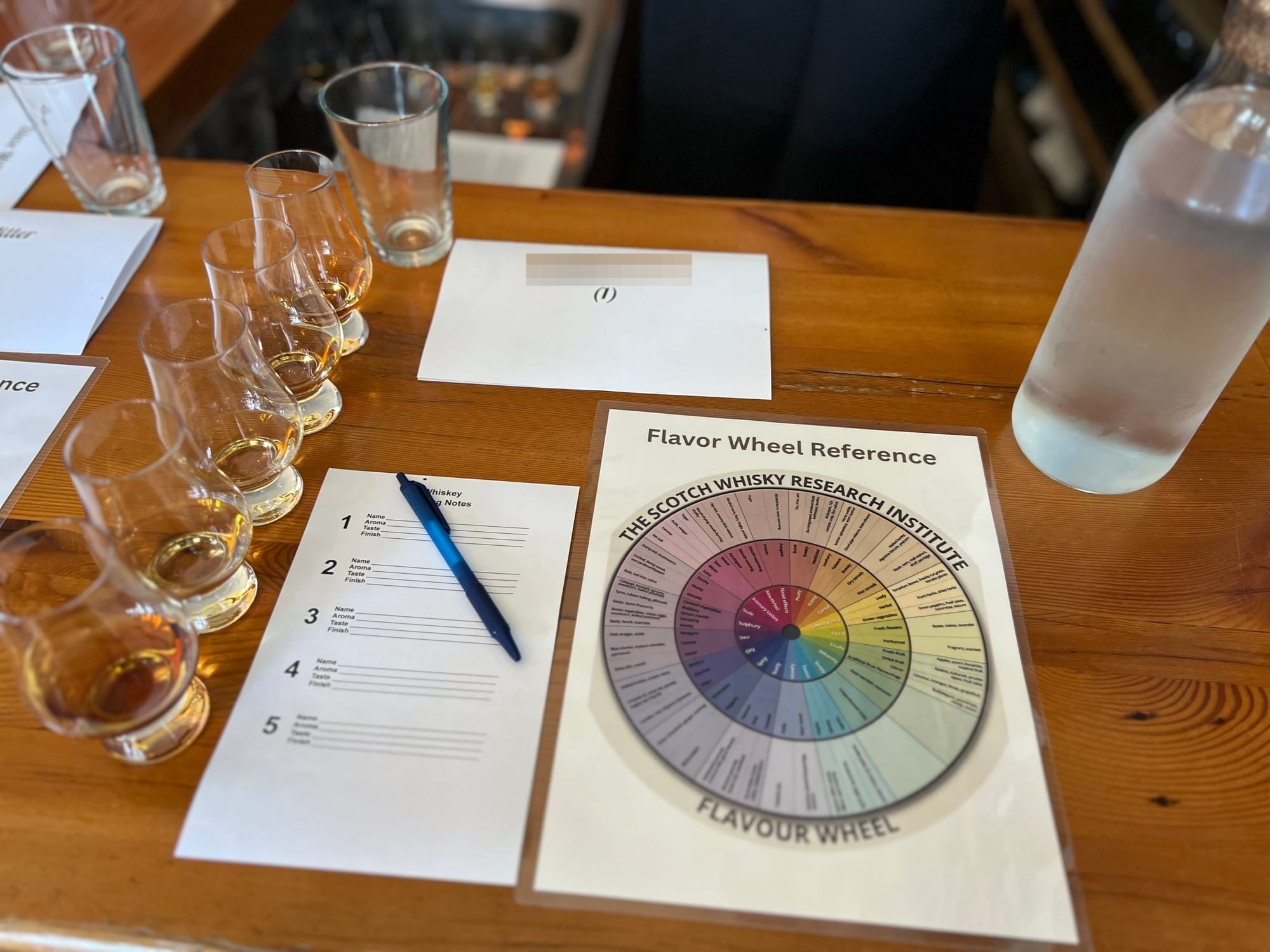Whisky Tastings - What to Expect and How to Prepare

I've run several personal whisky tastings for friends and professional tastings for local bars and restaurants. If you're interested in doing the same, I'd like to explain my thought process for each tasting.

How to Choose Whiskies for a Whisky Tasting
Unsurprisingly, choosing the whiskies for a tasting can be stressful. The choices can quickly become overwhelming.
Don't be afraid to let your personality show in your choices. Every person will have a specific taste and style. You'll have more flexibility when tasting with friends, and my choices for personal tastings are often quite eclectic. I like to choose a theme for professional tastings to help focus the choices and give a preview to paying customers.
When choosing whiskies for a tasting, my number one rule is that every whisky must add something unique or educate the consumer. Taste has to be a consideration, but every choice should offer something to make the whole better.
My latest tasting featured a flight of five Bourbons. I developed the theme of how distilleries create new and exciting flavors despite its strict legal definition.
Wyoming Whiskey Straight Bourbon–I love the unique flavor profile of Wyoming Whiskey, with notes of black tea and eucalyptus and a lovely candied orange. This Bourbon shows how aging in different environments lends unique flavors.
Eight Oaks Pinot Noir Finished Bourbon–Besides being a local farm-to-glass distillery, this Bourbon highlights what finishing can do to introduce new flavors. It features vanilla and a nice black cherry from the wine finish.
Four Roses Single Barrel—Four Roses is one of the big names in the Bourbon industry, but its innovation is still impressive. It uses five types of yeast and two mash bills and ages its whiskey in one-level warehouses to prevent more variables from interfering with the flavor profile. The Single Barrel releases encourage your audience to investigate each recipe and find the differences.
Joseph Magnus Straight Bourbon–Joseph Magnus Straight Bourbon highlights the power of sourcing and blending. I used their story–Joseph Magnus was a merchant not unlike Johnnie Walker, whose descendants recreated his Bourbon blend–to help the audience experience what sourcing can do. Despite the stigma sourcing sometimes has in the U.S., this whiskey, finished in Oloroso, Pedro Ximenez, and Cognac casks, demonstrates the high quality achievable through this model.
Old Elk Master's Blend Series Four Grain Bourbon–This is a four-grain Bourbon made by blending a high rye Bourbon with a wheated Bourbon (both sourced from MGP) to provide a final product with all four grains. Instead of adding all four grains to the mash bill, blending is a distinct way of creating a four-grain Bourbon, one of my current favorites in this category.
One final tip: I like to add a "weird" whisky to the tasting when possible to make things interesting. For my Japanese whisky tasting, I added Ohishi whisky, made from rice, to add something different to the other choices, which all came from powerhouses Suntory and Nikka. Rice whisky is rare, and Ohishi–an independent farm distillery in southern Japan– offers a romantic story and a feeling of authenticity. My weird choice for the world whisky tasting was a rapid-aged whisky from Switzerland, Seven Seals Sherry Wood Finish. An odd choice makes the customers feel like they were taken on an adventure.
1. Choose a theme
2. Make every choice earn its place
3. Add one "weird" choice to make things interesting.

How to Present Whisky to an Audience
Public speaking is terrifying to many people. I wouldn't be surprised if getting up in front of an audience and guiding them through a flight of whiskies is much more stressful than any other part. However, while a public speaking course is way beyond the scope of this article, I can give you some tips to help you relax and keep things under control.
First, remember that everyone who attends a whisky tasting is there to have fun. None of them are rooting for you to fail. If you mess up, admit it, make fun of yourself, and move on. Never take yourself too seriously; you'll be sure to endear yourself to the audience by letting your guard down a bit.
I like to start every tasting with a story about the style of whisky or the theme I've chosen. For example, if your tasting features Japanese whisky, begin with a history of whisky in Japan, how it got there, and how it's changed throughout the years. Keep this part to 10 minutes or less so the tasters don't get restless.
Every whisky has a story. Sometimes, the distillery is unique in some way, and sometimes, the specific bottle has an interesting backstory. Stories are an essential part of the whisky-drinking experience, and they help you keep the audience's attention and let them know why you put this whisky into the lineup.
Spend about 10-15 minutes per sample. Give people a chance to nose and taste it on their own and figure out what they're tasting, then provide your tasting notes to help those who may not be getting much at first. Balance is required. If you take too long, people become restless and begin side conversations. Go too fast, and they'll feel rushed and anxious. Announce when you're ready to move on and allow time for someone to speak up to ask questions.
My whisky tastings last two hours, and my run through the flight lasts about 60-70 minutes. I then walk around the room, greeting and chatting with everyone I can about their thoughts and favorites. Connecting with the audience is an excellent opportunity to build my brand and gain insight into what people may want to taste the next time. Some have even given me feedback on how to improve. Whisky is about community, and taking the time to greet my guests personally helps them realize that I'm there to serve them; it's not just a business transaction. I also tend to bring a special bottle from my collection to share with some who may stay later afterward to hang out.
You don't need much equipment for tastings. If you expect the room to be loud, bringing a microphone and speaker will help. In my experience, the room gets louder as the tasting goes on. People will begin having side conversations by the last couple of drams, and the volume will increase. You can tap a wine glass or use the microphone to get everyone to refocus on you and the next whisky. I also bring laminated tasting wheels to distribute and help customers find flavors as they taste, but that's not required. Finally, providing a small piece of paper or notepad for each guest to write on is very helpful. Many will write down their favorites and their prices so they can buy them later.
Of course, if you're doing a tasting with friends, you don't have to be so formal. My personal tastings have a ton of different whiskies and we drink in whatever order the group feels like drinking. Those tastings are all about fun, with me sprinkling some cool facts where appropriate.
1. Don't take yourself too seriously. Be professional yet friendly.
2. Tell stories to inform the audience and keep their attention.
3. Give 10-15 minutes per sample, and keep things moving.
Educate and Explore
I get that not everyone wants to do professional whisky tastings. Even if you don't want to do it professionally, personal whisky tastings with friends can be tons of fun, so give them a try. Be sure to attend some to expose yourself to new flavors and learn how others do it. Whisky tastings exemplify the true beauty of whisky: great flavors with great friends.





